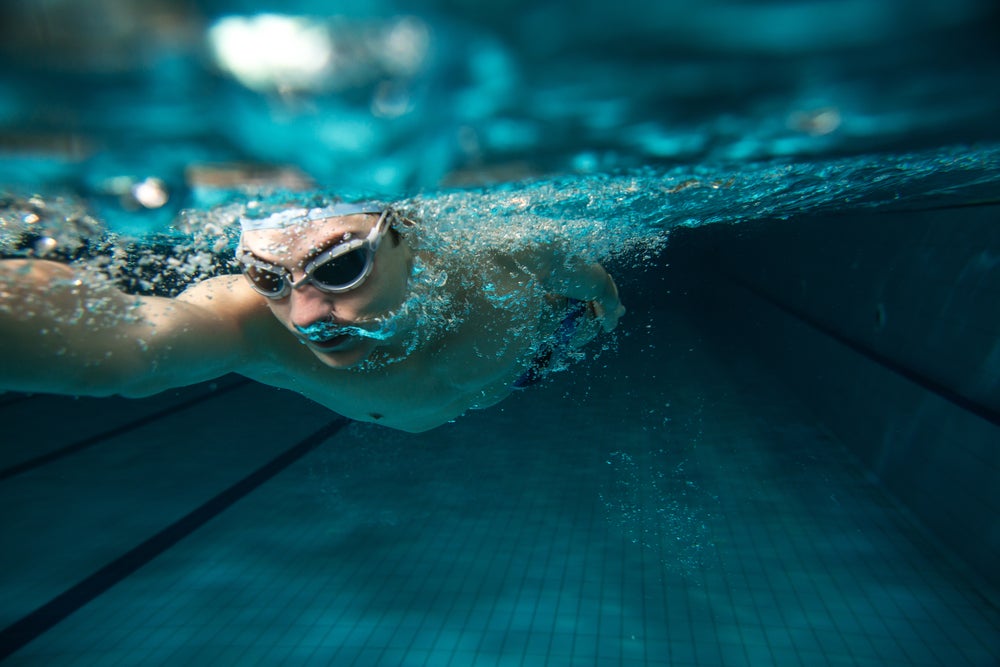Ask Coach Sara: How Do I Get My Sinking Hips Up?

Photo: <a href=http://shutterstock.com>Shutterstock.com</a>
Your questions about swimming as a triathlete, answered by coach and professional triathlete Sara McLarty.
Q: How do I get my sinking hips up? —@amdupras
A: I’m guessing that you probably try to hold yourself on top of the water instead of in the water by pressing your upper body up, which results in sinking hips. Practice a dead man’s float with just a light flutter kick to keep your legs at the surface. Tips for floating: neutral neck with face looking straight at the bottom of the pool; slight arch to your back to elevate legs toward the surface; arms extended over head but hands 4–6 inches below the surface; make constant but small adjustments to stay afloat. Once you are comfortable in this position, try to maintain it while swimming.
RELATED – Priority One For Swimmers: Get Level
Q: One of my new athletes (a former 800-meter runner) has a crossover kick where his ankles interlock when kicking. Any drills or suggestions?—@brooksdoughtie
A: Have your athlete practice basic kicking (with or without a board) and break the surface of the water with every kick. Once he is comfortable just kicking, add in a single stroke when he needs to breathe, still breaking the surface with his feet. When he has mastered this, move on to complete swimming, still emphasizing breaking the surface of the water to encourage an up-and-down motion with his legs and not sideways. He can also think about touching his big toes together as they pass each other in the kicking motion or train a bit with full-length fins to build kick strength.
RELATED: Is Your Swim Or Bike Strength Hurting Your Run?
Q: I can’t swim in a straight line in open water! Help! —@Walshtriguy
A: There are a number of things that cause us to swim off course. The first is single-sided breathing. Try to bilateral breathe as much as possible to stay straight. Next, don’t cross your center line with your hands. Make sure you are pointing your fingers toward your destination when they enter the water. Finally, the current, wind, waves and other swimmers can move you off course if you are not sighting often. Don’t go more than 10–12 strokes without a quick glance up at the next buoy to make sure you are still on course.
RELATED: 9 Secrets To Proper Open-Water Sighting
Q: What can I do to keep a good body position every time I push off the wall? —@RunnerSean
A: The fastest we move through the water is after pushing off the wall. Take advantage of this free speed in training by getting into a good streamline position and pushing off under the water. Place one hand on top of the other and extend your arms straight over your head. Squeeze your head with your biceps. Push off 2–4 feet below the surface of the water to prevent surface turbulence and maintain the streamline while kicking for 2–3 meters. As your momentum slows, angle toward the surface and start your first stroke just before your head breaks out of the water.
RELATED: Six Steps To A Better Streamline
Q: How do I work on a proper inhale and exhale breathing technique? I’m also dealing with water up my nose. —@bossmandan15
A: You are not alone—many novice swimmers hold their breath when their face is in the water. Just imagine trying to run or cycle and holding your breath between inhales! Breath holding creates a buildup of CO2, which creates the panic and anxiety that you might feel after a few laps. Swim breathing involves taking a quick inhale when your face is turned to the side and then a constant and steady exhale out your nose and mouth the entire time your face is in the water. Practice your exhale by humming which forces air out your nose and prevents water from going up it.
RELATED: How Do I Avoid Holding My Breath While Swimming?
Swim coach and former pro triathlete Sara McLarty has 25-plus years of experience and knowledge about swimming mechanics, efficiency and technique.